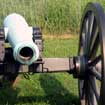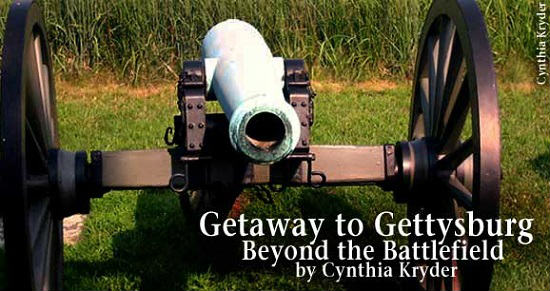

Known as the site of a major Union victory in the Civil War, Gettysburg lies in sleepy Adams County, in southern Pennsylvania. As in the 19th century, at least nine major roads converge around the town, one of the reasons General Robert E. Lee, commander of the Southern army, decided to send a Confederate brigade here to engage General George Meade’s Northern army in July, 1863. Today, Gettysburg’s central location is an easy drive from Pittsburgh, Philadelphia, Baltimore or Washington, D.C.
Although dominated by the Gettysburg National Military Park, one of the largest battlefield shrines in the United States, Gettysburg offers outstanding scenic beauty, entertainment and recreation for folks who aren’t history aficionados. Visitors have their choice of the Pennsylvania Lavender Festival in June, the Bluegrass Festival in May and August, and the Yuletide Festival during the first and second weekends of December, in addition to antique shows and outdoor concerts. For history buffs, year-round living-history encampments at Gettysburg bring the Civil War to life.
More than 1,000 monuments and cannons along 40 miles (64 km) of scenic avenues comprise the National Military Park, which commemorates one of the most decisive battles in United States history. To truly experience the area, you need at least two or three days. Because we were crunched for time — and accompanied by three teenagers who had a limited tolerance for sightseeing — we only spent one day there, but we packed as much into those few hours as we could.
We arrived on a hot and humid late summer day, with temperatures not unlike those of July 1, 2, and 3, 1863, when the historic conflict raged. Lucky for us, we were not wearing the government-issued wool uniforms worn by both armies back then.
Considering high temperatures and humidity, the prospect of sitting on the top deck of an open-air, double-decker bus and listening to a recorded tour wasn’t very appealing. Instead, we booked an air-conditioned, two-hour bus tour at the Gettysburg Battlefield Tour Center with a licensed guide.
We could have rented an audio recording from the national park and taken a self-guided tour in our own car, but being entertained by a live person seemed more interesting. For the more adventurous, the national park offers self-guided bicycle and walking tours, but on this summer day we opted for comfort.
The tour didn’t begin for two more hours, so we had just enough time to mosey south down Business Route 15 for a quick lunch at Boyds Bear Country, billed as the “world’s most humongous teddy bear store.” If you’re a collector of stuffed teddies, don’t miss this 120,000-square-foot (12,100 m²) barn and its four floors filled with bears of all types.
The complex sits on 130 acres (53 hectares) in the country, which offered a respite from the bumper-to-bumper traffic we experienced while driving through the center of town. And, with a family-style dining hall, a bakery, a deli, a fudge shop and a smoothie shack, we had plenty of reasonably priced choices to satisfy everyone’s palate.
One of the perks of purchasing a bus-tour ticket was the coupon we received for a free Boyd’s bear. Even the husbands in our group received coupons, although they didn’t want the bears. When we tried to hand the coupons back, the receptionist shook her head and advised, “Sell the extras on eBay.” After cashing in our coupons, we left with seven Boyds Bears without opening up our wallets.
No matter what kind of tour you take, viewing the hallowed ground of Gettysburg is a moving experience, but touring with a licensed guide personalizes the Civil War and the losses experienced by the North and the South: up to 51,000 men dead; more than 3,000 dead horses; and an estimated 569 tons of ammunition expended, making Gettysburg the bloodiest battle of American history.
Of course, if you were educated in the United States, you learned Civil War facts in your U.S. history class, but following the steps of those long-ago soldiers with a guide reveals interesting war-related tidbits, and gives you a unique perspective you can’t get with recorded tours. Many of the guides are retired history teachers who are passionate about this period of time.
Our teens asked insightful questions: Why did the soldiers wear wool uniforms? The fabric was sturdy and cheap, and didn’t wear out, like cotton. What happened to the dead or dying? They were left on the field of battle until the townspeople of Gettysburg could bury them. Did it smell? You bet. Imagine acres of fields covered with dead bodies, and swarming with flies and other insects. And finally, when did Lincoln get here?
A brief four months after the battle, President Abraham Lincoln arrived on November 19, 1863, to dedicate the Gettysburg National Cemetery, where the bodies of the soldiers who died here were eventually interred. His visit is best remembered by a two-minute speech, the Gettysburg Address. On Lincoln Square in the center of town, the David Wills House house, where Lincoln stayed while he finished his address, is still marked by red-white-and-blue bunting over the bedroom window. In 2008, the Gettysburg Convention & Visitors Bureau will move into the house.
We concluded our battlefield experience at the Visitor’s Center. Here you can explore Civil War artifacts and view the Electric Map, an electronic battle-orientation program that depicts various troop movements during the battle.

Adjacent to the Visitor’s Center is the Cyclorama Center, which has additional museum artifacts and a massive 360-degree painting that features the climax of “Pickett’s Charge,” showing the final engagement at Gettysburg, a frontal infantry attack on Union forces by Confederate soldiers, led by Major General George Pickett, which proved disastrous for his army. Completed in 1884, it is one of the last surviving cycloramas in the United States.
I found the museum to be dank and dreary, with case after case of relics that soon made my eyes glaze over. I wasn’t alone. The teens in our group were ready to stage the next Gettysburg Revolt, so we escaped the old-fashioned building and walked across the street to the Soldiers’ National Cemetery.
Fortunately, years ago, the National Park Service recognized the need for an updated building to replace the outdated Visitor’s Center and Cyclorama Center, in which to house the park’s extensive archival and museum collections. A new 139,000-square-foot (13,000 m²) Museum and Visitor’s Center is set to open in early 2008.
We barely scratched the surface of Gettysburg during our brief visit. A return trip calls for a stay in one of the many bed-and-breakfasts in the area and leisurely visits to the shops downtown. Also on our agenda are a candlelight ghost tour and a visit to the Eisenhower National Historic Site, the endearing former home of President Dwight D. Eisenhower and his wife Mamie, which remains filled with décor from the 1950s.
If You Go
The Gettysburg National Military Park
The Soldiers’ National Cemetery
www.nps.gov/archive
Eisenhower National Historic Site
Gettysburg Battlefield Tour Center
www.gettysburgbattlefieldtours.com
Gettysburg Convention & Visitors Bureau
www.gettysburgfun.com
